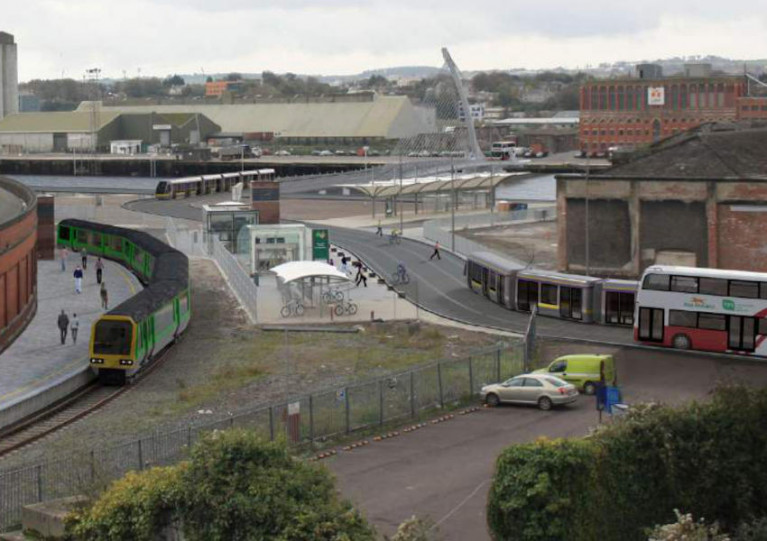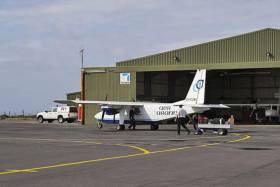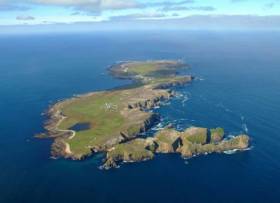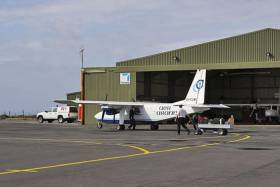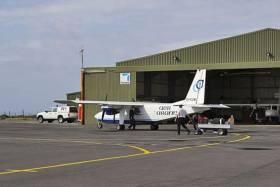Displaying items by tag: transport
Ministers Welcome EU Funding for Transport Projects Including Rail Connections With Seaports and Revamped Road Link to Rosslare Harbour
Irish Rail has been awarded €2.5 million for supporting studies for the development of a rail freight system connecting Ireland’s busiest seaports and establishing transfer points for freight between rail and road.
It’s one of a number of projects to benefit from a total of €13 million in co-funding for transport projects in Ireland under the European Union’s Connecting Europe Facility (CEF), announced today (Wednesday 29 June) by Transport Minister Eamon Ryan and Minister of State for the Department of Transport, Hildegarde Naughton.
These also include an award of €2.8 million to Wexford County Council to support its work in the planning and design phase of the N11/N25 between Oilgate and Rosslare Harbour.
The Connecting Europe Facility is a key EU funding instrument which aims to promote growth, jobs and competitiveness through targeted infrastructure investment at European level.
Minister for Rural and Community Development, Heather Humphreys has today announced the awarding of a new €4.9 million air service contract for the Aran Islands.
The PSO contract — which comes into effect on Tuesday 7 June — will run for four years until 2026 and will ensure essential mainland connectivity for the island communities. It’s also expected to significantly boost tourism, the department adds.
In addition, the new contract ensures for the first time the provision of a direct service from the mainland to Inis Meáin and Inis Oírr, which will mean a faster service for those smaller islands.
The contract with Galway Aviation Services Limited, trading as Aer Arann Islands, follows extensive consultation with island stakeholders and a full procurement process.
The air route has most recently been operated by Aer Arann Islands on an interim contractual basis. This came after the operator announced the termination of its PSO arrangement in mid 2018, citing profitability concerns.
Announcing the decision today, Minister Humphreys said: “This contract gives certainly to the communities of Oileáin Árainn. It ensures they can continue to avail of a year round, reliable and affordable air service to and from Aerfort Chonamara.
“And for the first time, we will now have direct flights to Inis Meáin and Inis Oírr – two wonderful island communities that are so steeped in history, culture and folklore.
“This is a fantastic development for these island communities. And it also sends a huge signal out ahead of the summer tourism season.”
The contract will provide 68,274 PSO seats annually to the three islands and will operate from Aerfort Chonamara at Inverin, which was purchased by the State in 2019.
The contract will also see the introduction of a flexible scheduling scheme that will allow operator to better respond to local service demands, such as island festivals and events.
Ad-hoc and scheduled non-PSO flights will also be provided by the operator to meet any demand above the agreed PSO seating allocation, the department says.
River Lee Light Rail Bridge Plans ‘Could Sterilise Cork City For Future Generations’
Plans for a new light rail bridge across the River Lee in Cork city centre have sparked concerns that the project would prevent any passage of vessels and “sterilise the city forever for future generations”.
The Echo reported last week on the multi-billion-euro transport plan for Cork that includes a light rail system similar to the Luas in Dublin, with a 25-stop route that could cross the city via a new bridge at Kent Station to the South Docklands.
This is the proposal that has raised the ire of Michael McCarthy, chairman of cruising industry network Cruise Europe, who fears the bridge would cut off the city from its maritime heritage.
McCarthy cites the pontoon by the coffee pods on Lapps Quay — “nothing but a few small rowing boats” — as an example of what could happen to the city without free access for vessels of all sizes.
And he argues that some councillors and officials who will be responsible for considering these plans have “no feel or empathy for the maritime or the marine”.
“The river made Cork City what it is today and now they are intent on sterilising it for ever when there is a very viable alternative,” he adds — suggesting that the light rail system could instead follow the old Cork-Blackrock-Passage-Crosshaven line using the existing bridges from Kent Station to City Hall.
Cork City councillors were briefed last week by the National Transport Authority on the plans, which form part of the Cork Metropolitan Area Transport Strategy (CMATS).
Next month a specialist team will be commissioned to analyse all route options for the scheme, which is expected to cost €1 billion in total. The Echo has more on the story HERE.
New Guidelines For Accessible Maritime Passenger Transport
The Department of Transport, Tourism and Sport (DTTAS) recently published new accessibility guidelines designed as a support to all those involved in providing maritime passenger transport services.
This includes passenger vessel owners and operators, port operators and local authorities, as well as Government departments with a statutory remit in relation to maritime passenger transport services.
The advice given covers all aspects of a journey, including:
- Advice on providing accessible information for planning the journey
- Improving access on board vessels
- Making shore-side facilities accessible
- Disability awareness training for staff
- Improving communications with passengers
The full guidelines are available from the Government website as a PDF to read or download HERE.
New Short-Term Deal Struck For Aran Islands Air Service
#IslandNews - Air service between the Aran Islands and the mainland has been saved for two more weeks after a short-term tender was agreed, as The Irish Times reports.
Aer Arann Islands gave notice in June that it would terminate its PSO arrangement for the service this month two years ahead of schedule, citing contractual terms that affect its profitability.
The company’s owner even offered earlier this week to sell the airline to the islands’ communities for a nominal €1 sum.
Flights were expected to halt after next Thursday 6 December but a last-minute deal with the Department of Culture, Heritage and the Gaeltacht will see the service continue till at least Thursday 20 December.
The Irish Times has more on the story HERE.
#AranIslands - Aer Arann Islands has given notice for termination of its PSO contract for the Aran Islands two years ahead of schedule, as RTÉ News reports.
The airline will end its flights between the islands and the Galway mainland at the end of December this year — once again throwing into doubt the future of the islands’ decades-long air service.
The current PSO contract was only signed in January last year after months of uncertainty, and should have secured flights between Inis Mór, Inis Meann and Inis Óirr until the end of 2020.
However, it is understood that the imposition of additional passenger fees for unscheduled journeys became a sticking point just weeks into the new arrangement.
Without mediation to resolve the issue, the airline says it can no longer continue the contract as it stands.
The news comes six months after the signing of a new ferry contract to guarantee daily ferry service to the islands until November 2022.
Tory Islanders Agree To New Passenger Ferry Deal
#IslandNews - Residents of Tory Island have voted in favour of a compromise proposal in their dispute with the State over a new ferry contract.
As previously noted on Afloat.ie, people living on the island off the Donegal coast feared the loss of their community with the planned introduction of a new ferry service that they argued was unsuitable for their needs.
But as The Irish Times reports, islanders have agreed in the majority to back a report presented to them on Friday (23 March) by mediator Pól Ó Gallchóir, and which also recommends a full departmental review of island transport around the Irish coast.
The revised proposal would see Tory Island get a new 12-passenger fast ferry alongside the 40-year-old Queen of Aran, the latter of which begins operation on the 15m route to the mainland next weekend.
Also recommended in the report is increasing the annual window for cargo runs and extending the HSE helicopter service over the winter months.
The Irish Times has more on the story HERE.
Contract Signed For Aran Islands Flights
#AranIslands - Galway Bay FM reports that a new contract for the decades-old aeroplane service to the Aran Islands has been signed.
As previously reported on Afloat.ie, the long-awaited PSO contract will see flights continue between the Galway Bay islands and the mainland at South Connemara till at least the end of 2020.
The agreement follows months of uncertainly over the future of the air link due to costs on the route.
Only two weeks ago, local Senator Trevor O’Clochartaigh queried the contract’s imposition of additional fees for passengers on unscheduled flights.
Senator Raises Issue Of Levy For Unscheduled Aran Islands Flights
#AranIslands - Issues remain with the new contract for Aran Islands air services, according to one local senator.
As Galway Bay FM reports, Senator Trevor O’Clochartaigh says the new PSO agreement imposes additional fees on flights not specified on the schedule.
The situation means that passengers on an extra flight for a funeral or in other exceptional circumstances might have to pay more than €30 extra for their seat.
Only three weeks ago, residents in the Galway Bay islands – who have also recently faced the prospect of losing their winter ferry service – were given certainly that their air link to the mainland would continue till at least the end of 2020.
But O’Clochartaigh says Gaeltacht Minister Seán Kyne can still act to make arrangements so that islanders are not left out of pocket. Galway Bay FM has more on the story HERE.
Aran Islands Flights Confirmed For Another Four Years
#AranIslands - While Inis Mór’s winter ferry link with the mainland remains in question, Aran Islands residents at least have an answer to their air service woes.
According to Galway Bay FM, Aer Arann Islands has been selected as the State’s preferred tender for the long-running route to the islands in Galway Bay.
The new PSO contract for the islands to Na Minna airport near Rossaveal runs from 1 January 2017 to the end of 2020, confirming continued flights for another four years.
The move follows several extensions to the existing contract that saw the State and Aer Arann at deadlock over costs on the route, as well as a controversial tender in 2015 to replace the decades-old airplane route with a helicopter service.
Meanwhile, an Oireachtas committee was addressed last week by a group representing Inis Mór residents as the dispute over the island’s winter ferry service continues.


























